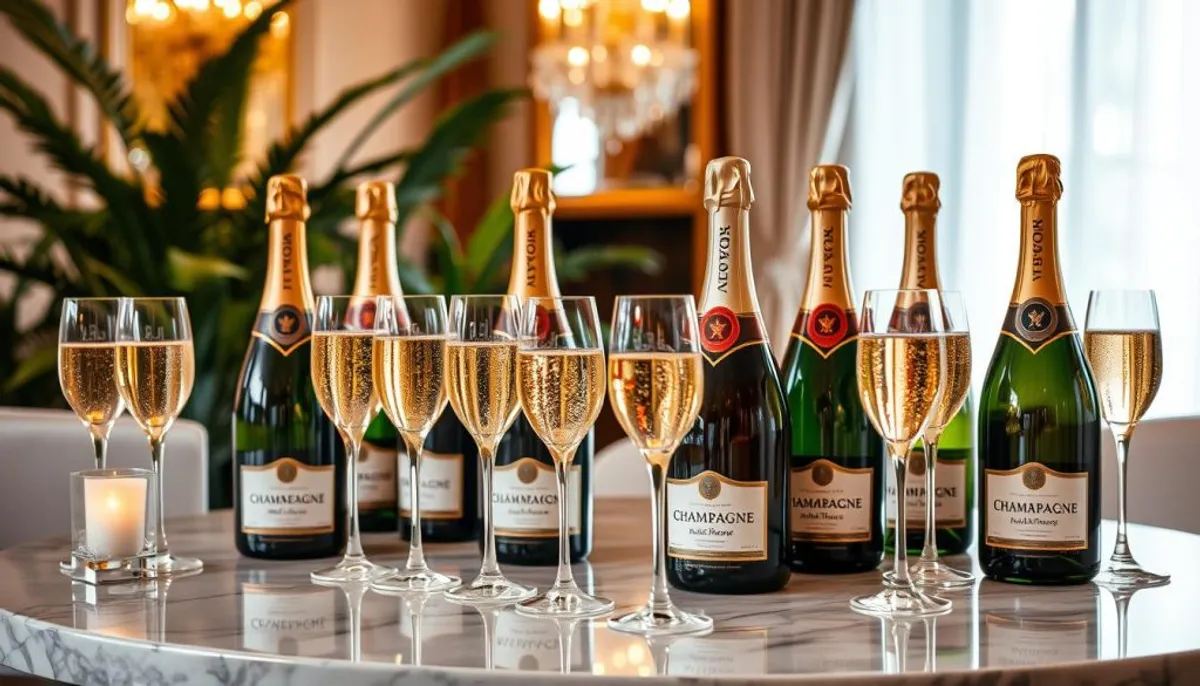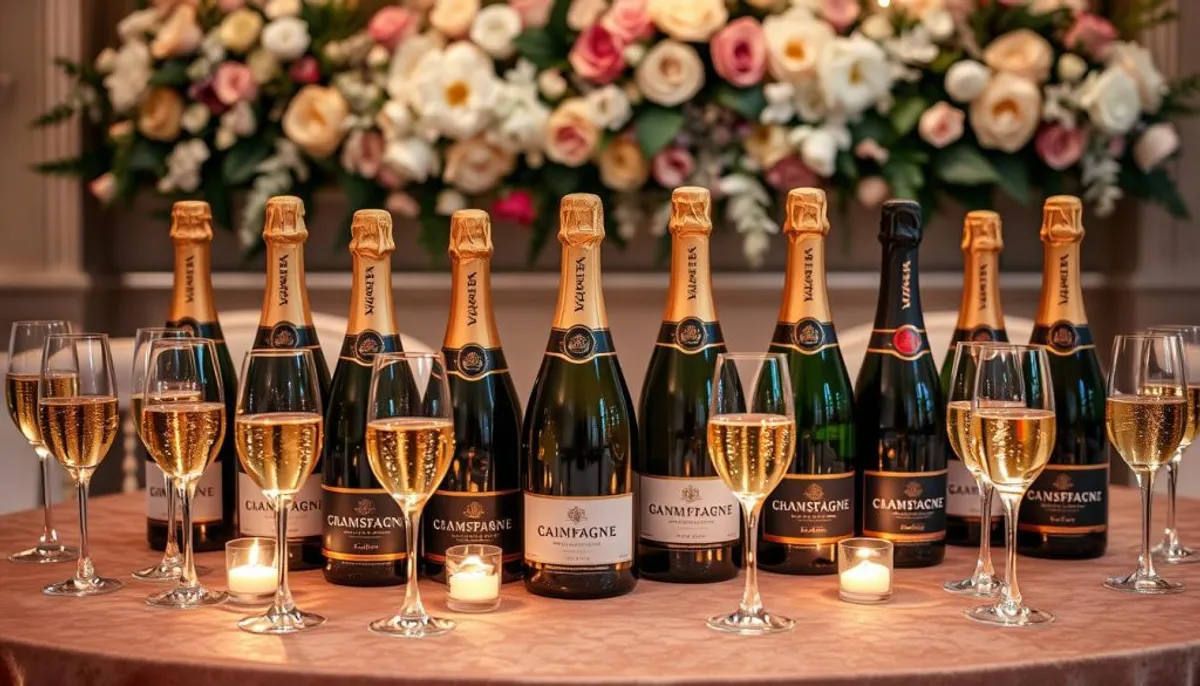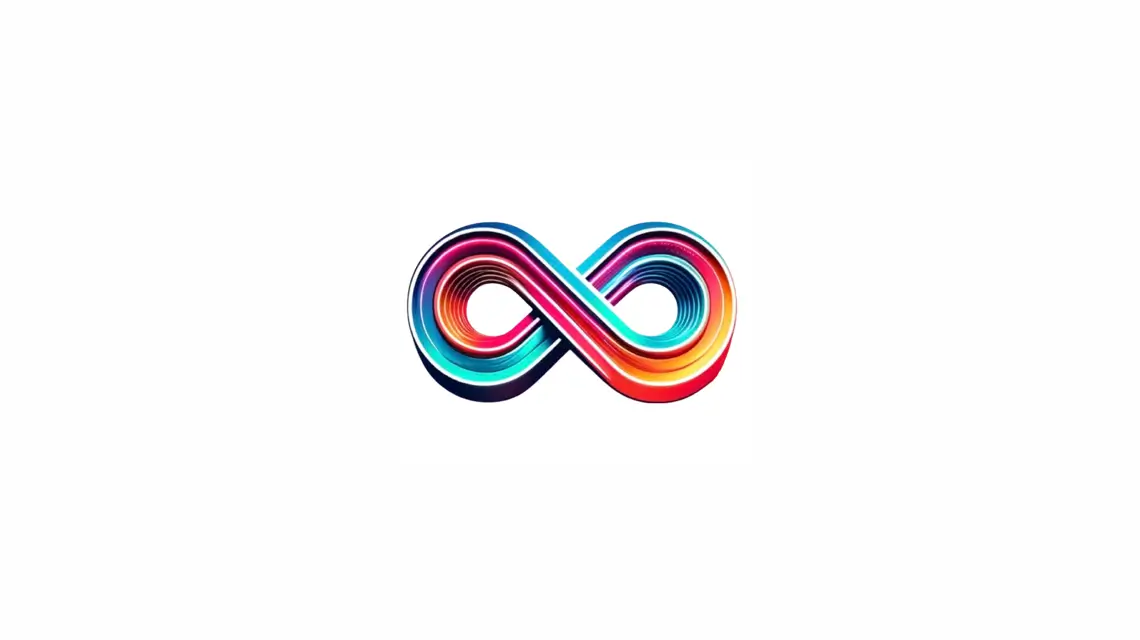Step into the realm of luxury champagne with our exquisite collection from France. The sparkling legacy from Champagne’s rolling hills has enthralled connoisseurs for centuries. Our selection of premium sparkling wine highlights the pinnacle of exclusive champagne brands, each bottle a reflection of centuries of winemaking mastery.

Explore our curated collection, featuring iconic labels such as Möet, Veuve Clicquot, Bollinger, Taittinger, and Laurent Perrier. These esteemed brands present a spectrum of flavors, ranging from the delicate white flower and citrus notes to the rich brioche and toasted almond aromas. The champagne’s dense, persistent, and creamy bubbles create a sensory experience that elevates any event to unparalleled heights.
Whether for a romantic dinner, a milestone celebration, or to simply enhance your day, our premium champagne collection offers the ideal choice. Enjoy free shipping across Europe on orders exceeding €150, making it effortless to bring French champagne’s elegance to your doorstep.
Key Takeaways
- Exclusive selection of French champagne brands
- Free shipping in Europe for orders over €150
- Centuries of winemaking expertise in every bottle
- Variety of flavors and aromas to suit every palate
- Perfect for celebrations and special occasions, including champagne for special occasions
- Limited editions available for collectors
- Range of bottle sizes from half bottles to magnums
The Royal Heritage and History of Champagne
Champagne’s storied past is deeply rooted in French royal heritage. This effervescent wine, born in the 17th century, swiftly became the preferred choice of monarchs and nobles. The Champagne region, nestled in northeastern France, retains the exclusive right to produce this opulent beverage. This privilege has been legally safeguarded since the early 20th century.
The Birth of Champagne in France’s Elite Society
Champagne’s ascent to prominence started in France’s royal courts. Its distinctive effervescence and taste captivated the elite, solidifying its status as a luxury and celebration emblem. The region’s unique terroir, characterized by chalky soil, gentle slopes, and a cool climate, is ideal for cultivating the primary grape varieties: Pinot Noir, Chardonnay, and Pinot Meunier.
Dom Pérignon’s Revolutionary Contributions
Dom Pérignon, a Benedictine monk, was instrumental in champagne’s history. In the 17th century, he elevated champagne’s quality by refining grape blending techniques. His groundbreaking winemaking innovations established the méthode champenoise, the traditional method that defines champagne’s signature bubbles.
Evolution into a Global Luxury Symbol
The 19th century was a pivotal era for champagne’s evolution into a global luxury symbol. Champagne houses astutely linked their products with royalty and nobility, enhancing its prestige. Today, champagne is celebrated globally, representing celebration and sophistication. The Champagne Heritage Prince Henri d’Orléans, Altesse Royale, exemplifies this legacy, blending French artisanal expertise with traditional winemaking techniques.
Understanding the Méthode Champenoise
The Méthode Champenoise is the bedrock of champagne production. Over centuries, this traditional method has evolved, yielding the world’s most revered sparkling wines.
Traditional Harvesting Methods
Champagne production commences with meticulous grape selection. Pinot Noir, Chardonnay, and Pinot Meunier are the primary grapes used. The Champagne region boasts over 82 Pinot Noir clones, enhancing the wine’s complexity. Grapes are picked when they reach specific sugar levels, usually between 17.5 to 20 °Brix.
The Art of Double Fermentation
The double fermentation process is the hallmark of the méthode champenoise. The first fermentation produces a still wine. The second, occurring in the bottle, generates the wine’s signature bubbles. This intricate process involves blending base wines with yeast and sugar.
Aging and Maturation Process
Champagne aging is vital for developing its complex flavors. Non-vintage Champagnes must age on the lees for at least 12 months. Premium champagnes, on the other hand, may mature for years, with some vintages released after over 20 years. This prolonged aging period enriches the wine’s depth and character.
| Grape Variety | Titratable Acid (g/L) | pH Level |
|---|---|---|
| Chardonnay | 10.0 – 14.0 | 2.9 – 3.15 |
| Pinot Noir | N/A | 2.9 – 3.15 |
| Chenin Blanc | 10.0 – 14.0 | 3.1 – 3.2 |
Premium Champagne Varieties and Styles
Champagne styles cater to a wide array of tastes, ranging from dry to sweet. Each variety presents distinct characteristics, tailored to suit various preferences and occasions. This diversity ensures that there is something for everyone.
Brut and Extra-Brut Classifications
Brut champagne is the preferred choice for celebrations, known for its dry and lively nature. It is ideal for toasts and gatherings. Extra-Brut, on the other hand, offers an even drier taste, appealing to those who prefer minimal sweetness. These styles are favored by health-conscious drinkers due to their lower sugar content.
Vintage vs. Non-Vintage Collections
Vintage champagne is crafted from grapes of a single exceptional harvest year. It is complex and highly regarded by connoisseurs. Non-vintage blends grapes from multiple years, ensuring a consistent quality. Vintage bottles are often more expensive due to their rarity and aging potential.
Blanc de Blancs and Rosé Specialties
Blanc de Blancs, made exclusively from Chardonnay grapes, presents light and elegant flavors. Rosé champagne, with its fruity notes, is perfect for romantic dinners. These specialties highlight the versatility of champagne production techniques.
| Champagne Style | Characteristics | Best For |
|---|---|---|
| Brut | Dry, lively | Celebrations |
| Extra-Brut | Very dry, intense | Low-sugar preference |
| Vintage | Complex, aged | Connoisseurs |
| Blanc de Blancs | Light, elegant | Seafood pairings |
| Rosé | Fruity, pink-hued | Romantic dinners |

Premium champagne prices vary significantly. Tête de cuvée bottles typically range from $200 to $300, reflecting their exclusivity. For those seeking more affordable luxury, brands like Mumm Napa offer quality at around $20. The average price for premium champagne is $57.79, with an average discount of 23%.
World-Renowned Champagne Houses
The Champagne region is home to a multitude of luxury champagne houses, each with its own distinct narrative and aesthetic. These establishments, ranging from ancient estates to modern innovators, have collectively defined the champagne industry for millennia.
Moët & Chandon, established in 1743, is a behemoth in the champagne world, renowned for its Dom Pérignon line. This line embodies the pinnacle of luxury and quality. Veuve Clicquot, founded in 1772, is celebrated for its iconic Yellow Label Brut. Ruinart, dating back to 1729, is known for its exquisite Blanc de Blancs, crafted solely from Chardonnay grapes.
Taittinger and Louis Roederer, both with storied pasts, are recognized for their prestigious cuvées, such as La Grande Dame and Cristal. Smaller, family-owned houses like Bollinger and Pol Roger, though less well-known, are highly regarded for their commitment to quality. They have earned the admiration of connoisseurs worldwide.
| Champagne House | Founded | Signature Champagne |
|---|---|---|
| Moët & Chandon | 1743 | Dom Pérignon |
| Veuve Clicquot | 1772 | Yellow Label Brut |
| Ruinart | 1729 | Blanc de Blancs |
| Louis Roederer | 1776 | Cristal |
The champagne industry is constantly evolving, with newcomers like Armand de Brignac and Le Chemin du Roi introducing innovative perspectives. This diversity, including various french champagne varieties, spanning from grand maisons to boutique producers, ensures there is a champagne suitable for every taste and event.
Perfect Pairing Guide for Premium Champagne
Champagne food pairing is an art that elevates your dining experience. It offers versatile options for every course, from appetizers to desserts. Let’s explore the perfect combinations to enhance your meals.
Appetizers and Champagne Combinations
Champagne and appetizers create a delightful start to any meal. Pair a Brut champagne with seafood or light hors d’oeuvres. The crisp acidity cuts through rich flavors, cleansing your palate between bites.
Main Course Pairing Suggestions
For main courses, consider the champagne’s body and flavor profile. A Blanc de Blancs complements fish or poultry dishes. Pinot Noir-based champagnes stand up well to red meats. The Georges Remy Blanc de Noirs 2018, made from 100% Pinot Noir, pairs excellently with steak.
Dessert and Champagne Harmony
Champagne with desserts can be magical. Rosé champagne pairs wonderfully with fruit-based desserts. For chocolate treats, try a Demi-Sec champagne. The Pierre Legras Monographie Extra Dry, with its 14g/ltr dosage, offers a sweet touch to balance rich desserts.
| Champagne Style | Food Pairing | Example |
|---|---|---|
| Brut | Seafood, light appetizers | Moët & Chandon Réserve Impériale |
| Blanc de Blancs | Fish, poultry | Ruinart Blanc de Blancs |
| Rosé | Fruit desserts | Veuve Clicquot Rosé |
| Demi-Sec | Chocolate desserts | Laurent-Perrier Harmony |
Remember, champagne’s versatility makes it suitable for almost any dish. Experiment with different styles to find your perfect champagne food pairing.
Selecting the Right Champagne for Special Occasions

Choosing the perfect champagne for celebrations can elevate any special occasion. Champagne gifting has evolved into an art, offering options for every event and personal taste. When selecting special occasion wines, consider the nature of the gathering and the preferences of your guests.
For casual get-togethers, a classic Brut champagne offers versatility. Its balance of crispness and subtle sweetness pairs well with various dishes. Romantic dinners call for something more refined, like a Blanc de Blancs. Made exclusively from Chardonnay grapes, it showcases crisp acidity and elegant citrus notes.
Milestone events deserve a vintage champagne. These exceptional bottles reflect the unique characteristics of a single harvest year, offering a taste of that season’s essence. For business gifts, an Extra Brut presents a sophisticated choice with minimal added sugar, appealing to those who appreciate purity of flavor.
- Casual gatherings: Non-vintage Brut
- Romantic dinners: Blanc de Blancs
- Milestones: Vintage champagne
- Business gifts: Extra Brut
Remember, champagne for celebrations isn’t just about the occasion; it’s about creating memorable moments. Whether you’re toasting at a wedding or celebrating an achievement, the right bottle can transform an event into an unforgettable experience.
Expert Tips for Champagne Storage and Service
Proper champagne storage and serving techniques are essential for enjoying this luxurious beverage. We will explore expert tips to ensure your champagne’s quality and flavors are preserved.
Optimal Temperature Guidelines
Champagne temperature is critical for maintaining its taste. Store bottles between 50°F to 54°F (10°C to 12°C). For serving, chill non-vintage champagne to 45°F-48°F and vintage to 50°F-54°F. This temperature range ensures the best flavor and bubble retention.
Proper Glass Selection
Choosing the right champagne glassware enhances your drinking experience. Opt for tulip-shaped glasses or white wine glasses for vintage champagne. These shapes preserve bubbles and concentrate aromas, allowing you to fully appreciate the champagne’s complexity.
Storage Best Practices
Effective champagne storage involves more than just temperature control. Keep bottles away from direct sunlight and fluorescent lighting to prevent lightstrike. Maintain humidity levels between 60-80% to preserve cork integrity. For long-term storage, lay bottles horizontally to keep corks moist.
| Storage Type | Temperature | Humidity | Position |
|---|---|---|---|
| Short-term (3-4 days) | 46-50°F (8-10°C) | 60-70% | Upright |
| Long-term | 50-55°F (10-13°C) | 60-80% | Horizontal |
Remember, non-vintage champagne is best enjoyed within 3-5 years, while vintage varieties can age for 5-20 years or more. By following these guidelines, you’ll ensure your champagne remains in perfect condition for any occasion.
Investment Value of Fine Champagnes
Fine champagnes have become a promising investment avenue. The Liv-ex Champagne 50 benchmark surged by 94% between April 2020 and October 2022. This outpaced other wine regions, underscoring the rising value of rare and vintage champagnes in the investment sphere.
Prestigious houses such as Krug, Dom Pérignon, and Salon are at the forefront of this trend. For instance, the Krug 2008 Champagne saw its price double within its first year on the secondary market post-October 2021 release. Such rapid appreciation underscores the substantial potential for returns in champagne investment.
Several factors influence the investment potential of champagnes. These include the quality of the vintage, its rarity, and the reputation of the brand. The Louis Roederer Cristal 2015, for example, was the most valuable traded champagne, while Dom Perignon 2013 led in volume from 2019 to 2024. These trends reflect the robust demand for premium vintages from esteemed houses.
| Champagne | Market Price Change | Time Period |
|---|---|---|
| Salon Le Mesnil-sur-Oger 2012 | 392.9% | 2019-2022 |
| Louis Roederer, Cristal 2008 | 105.3% | 2019-2022 |
| 1993 Dom Perignon Oenotheque Rose | 98% | 2020-2022 |
Investors must prioritize proper storage to preserve champagne’s value. The market has demonstrated consistent growth over the last decade. This makes champagne a low-volatility investment with positive returns. With a well-thought-out strategy, fine champagne can significantly enhance an investment portfolio.
Conclusion
Exploring the realm of premium champagne collection reveals a world of luxury sparkling wine, captivating both aficionados and newcomers. The spectrum ranges from the budget-friendly Veuve Monsigny Champagne NV at £14.99 to the opulent Taittinger Brut Prestige Rose NV at £48. This variety ensures there’s a champagne to suit every taste and budget.
The champagne export industry excels in quality and variety. Veuve Clicquot Yellow Label dominates North American markets, with 1.5 million cases sold annually. Founded in 1743, Moët & Chandon produces an impressive 28 million bottles yearly. Their Impérial Brut is competitively priced at $50-$55, highlighting the industry’s commitment to accessibility and excellence.
Indulging in the Henriot Brut Souverain NV or discovering the distinct flavors of Barnaut Blanc de Noirs Grand Cru NV offers a glimpse into the artistry and heritage of champagne. Our carefully selected premium champagne collection invites you on a journey through the pinnacle of luxury sparkling wines.
RelatedRelated articles



